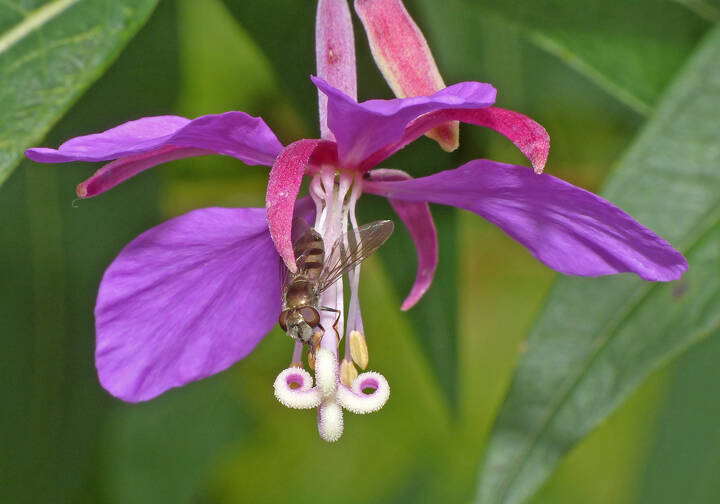Many plants produce flowers as a way of attracting animal visitors that can pick up pollen and move it to another flower. Flowers come in an array of colors — all the wavelengths we can see plus ultraviolet (which most humans cannot see). A yellow flower with a UV pattern is readily distinguishable from other yellow flowers — to the many kinds of animals (including insects and hummingbirds) that can see UV. That’s been known for many years.
However, flowers actually have (at least) two ways of enhancing their distinctiveness that humans generally cannot detect without special equipment. More recent research has found that plants can exploit another sensory system of animals.
There is a natural electric gradient from the ground (negative) up into the atmosphere (positive). And around every plant and its flowers there is a weak electrical field. Flowers have a negative charge (like the earth they come from), but they bloom in positively charged air, creating a little electrical field. Around the flowers that electrical field is strengthened: the electric effect is best developed around edges, such as the rims of petals and the inner (sexual) parts of the flower. So the size and shape of the flower is emphasized and made even more distinctive.
Bumblebees and other insects can detect the presence and shape of the floral electrical fields and use the information to decide which flowers to visit. Bees detect the electrical fields with their fuzzy hairs. The floral electrical fields are weak, but they are strong enough to deflect the hairs (just a wee fraction of a degree) and set off neural signals that the bees can interpret. Bees’ antennae can detect the fields too but no neural signal is sent on. Experiments with artificial flowers (identical in color, shape, and size) with and without nectar rewards and with and without electrical fields around them showed that bees quickly learn to choose the rewarding, electrical flowers.
Further research revealed that hoverflies, which are also important pollinators, can also do this well. Their body hairs are deflected by small electrical fields and a neural signal is sent. The flies learn to read the signal and their efficiency and speed of finding floral nectar rewards increases.
Electricity also helps move pollen from floral anthers to insects, because insects have a positive charge and the flower a negative one. So loose pollen can actually jump small distances from anther to insect, even before the bug lands. If the plant is lucky, the insect carries the pollen to another flower. If not, a bee may groom the pollen off its body and packs it away in its pollen baskets to feed bee larvae.
Plants are commonly used as platforms for transmitting vibrational signals, usually among themselves. For example, treehoppers suck plant sap, often gathering in considerable numbers on plants. The treehoppers contract their abdominal muscles very fast, creating surface vibrations that move over the plant. We can’t hear them without the aid of special devices, but the vibes are picked up by the legs of other treehoppers. Those vibrations are like songs, varying in pitch and tempo, and are clearly interpreted by the receivers.
Some songs are used for courtship, drawing male and female closer together; a second male can jam the first male’s songs and decrease a female’s response, thus interfering with the courtship. Baby treehoppers (called nymphs) emit cries of alarm when danger is perceived; this elicits defensive behavior of the mother, who signals after evicting a predator, calming the nymphs.
Lots of other insects (and spiders) can communicate with each other using plant vibrations. Many female insects use variation in male vibrations to choose the right species and the best male to mate with. It goes the other way too: males can use female vibrations to discriminate among females. Insects such as katydids make sounds we can hear, but they also make vibrational signals that indicate body size, and females prefer larger males.
Leaf-cutter ants create vibrations when chewing into leaves; if it’s a really good leaf for growing fungi to feed the colony, the distinctive vibrations can recruit other foraging ants to exploit the good resource. The larvae of some insects use vibrations to attract others of the same kind or to keep competitors away.
A typical range of transmission for most of these vibrational signals is up to about two meters, although it can be longer for large insects and spiders. All vibrational calling is energetically expensive, and some studies have shown that an insect that calls a lot is not likely to live as long as one that calls infrequently. The host plants that provide the platform have different vibrational properties, so they differ in their signal transmission capacity.
Some plant-based vibrations are not meant as communication among members of the same species. Vibrations produced by feeding, for instance, can be risky if it attracts predators—and lots of potential predators can track such vibrations. For example, a feeding caterpillar inadvertently gives vibrational cues to a predatory stinkbug and perhaps to parasitic wasps. In contrast, some butterfly caterpillars vibrate along with chemical signals to call in mutualistic ants to provide protection from predators. And there’s a spider that mimics the vibrational signals of the males of other species, to lure females of those species into hunting range for the mimicker.
Clearly, plants do far more than most of us ever imagined! That’s just a sample of sensory worlds that humans cannot experience directly. We miss a lot!
The stories of electric flowers and singing tree hoppers came mainly from a fascinating book about the sensory world of animals (“An Immense World,” by Ed Yong).
• Mary F. Willson is a retired professor of ecology. “On the Trails” appears every Wednesday in the Juneau Empire.

